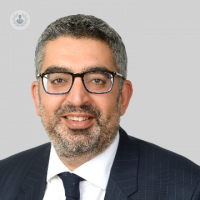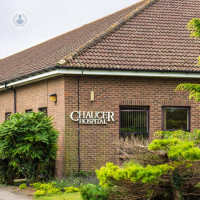Ganglion cyst
Mr G Shyamalan (Shyam) - Orthopaedic surgery
Created on: 11-13-2012
Updated on: 07-20-2023
Edited by: Aoife Maguire
What is a ganglion cyst?
A ganglion cyst is a benign but painful growth, usually on the hand or wrist. The pain often comes on at night, or after constant use of the hand.
Ganglion cysts can vary in size, growing up to three centimetres wide. While the position of the cyst doesn’t tend to change, the size may fluctuate over time, and some go away entirely without treatment.

Can a ganglion cyst be cured?
As previously mentioned, ganglion cysts sometimes go away on their own. If the cyst persists, treatment may be recommended to reduce the size or attempt to remove it completely. Unfortunately if the cyst is removed there is still a chance that it will come back, and you may need further treatment.
What are the symptoms?
Cysts usually form a visible nodule, although in some cases if the cysts are small they may not be noticeable.
Many of them have no symptoms, but if they do press on a nerve, it can cause pain, tingling and muscle weakness.
How is a ganglion cyst diagnosed?
Usually a ganglion cyst can be diagnosed by your GP with a physical examination. They may use a syringe to draw out fluid from the cyst. In some cases, they might refer you for an ultrasound or MRI to look at the inside of the lump and rule out other potential causes.
What causes a ganglion cyst?
The cause of ganglion cysts is unknown. They have been found to be more common in young people between the ages of 15 and 40 and to develop more in women. It is also more likely to be developed by people who use and overload the wrist. People who have arthritis may develop them more easily.
Can ganglion cysts be prevented?
At the moment it is not clear how to prevent ganglion cysts. The best thing to do is to see you doctor early on if you notice anything unusual.
How are ganglion cysts treated?
For many people, treatment will not be necessary especially if there is no associated pain. The main job of the GP will be to reassure you that the lump is not caused by anything more serious.
However, if the cyst is causing you pain the GP may recommend treatment. The two main forms of treatment for ganglion cysts are:
- aspiration – this involves using a syringe to take fluid out of the cyst, then anti-inflammatory medication on the remaining bump.
- surgery – the normally recommended if the cyst is pressing on your nerves and causing pain, with the possibility of permanent nerve damage.
Surgery is a more complex treatment and may involve putting your hand in a splint for several days afterwards. However, it tends to result in fewer recurrences of the cyst compared to aspiration. You can visit an orthopaedic surgeon can perform this surgery.








